Year 5 White Rose Overview
With thanks to Third Space Learning for this overview:
Topics covered in Year 5 White Rose Maths scheme of learning
Year 5 autumn term
- Place value
- Addition and subtraction
- Multiplication and division A
- Fractions A
Year 5 spring term
- Multiplication and division B
- Fractions B
- Decimals and percentages
- Perimeter and area
- Statistics
Year 5 summer term
- Shape
- Position and direction
- Decimals
- Negative numbers
- Converting units
- Volume
White Rose Maths Year 5 autumn term
In the autumn term, Year 5 focuses on place value, addition & subtraction, multiplication & division and fractions.
Place Value Year 5
By the time pupils reach Year 5, place value continues to be the first concept covered, but with a shorter length of time spent on it than in previous years. In autumn block 1 students work with increasingly larger numbers; reading, writing, comparing and ordering numbers to 1,000,000 and continue to develop their understanding of Roman numerals. Pupils build on their understanding of rounding; round to the nearest 10, 100 and 1000.
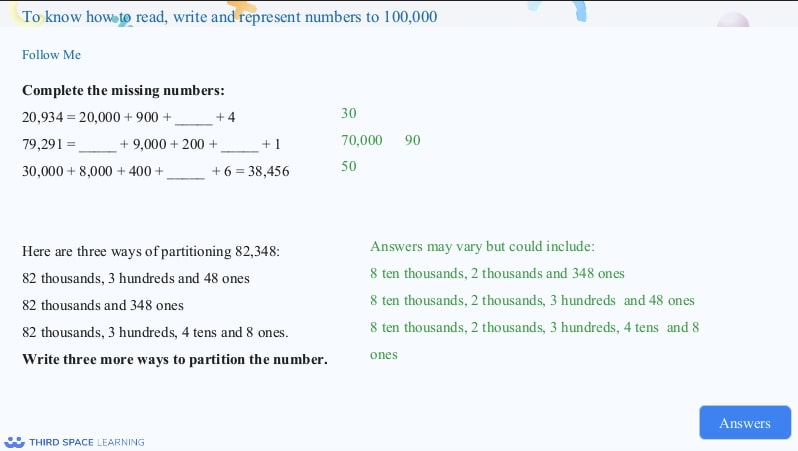
In this example, pupils partition numbers to 100,000 using standard and non-standard partitioning.
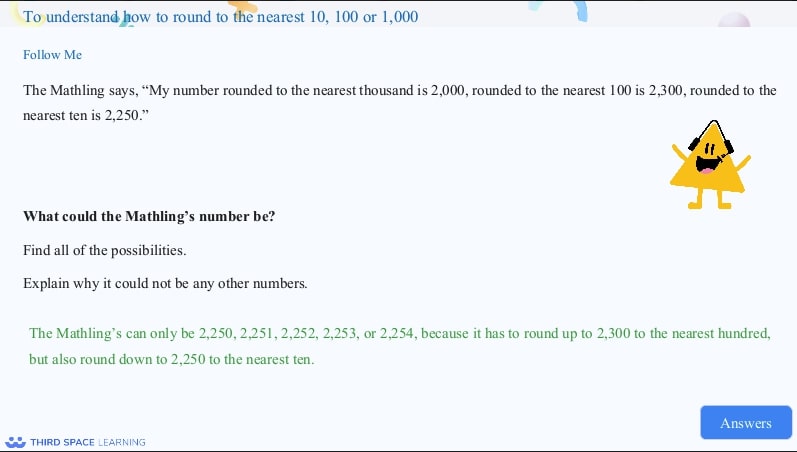
This example explores applying understanding of rounding to different degrees
of accuracy to a worded problem.
Example year 5 place value questions
1. What is the value of the underlined digit in each number below?
a)534,641 b) 718,076 c) 921,759
Answers:
- 6 hundreds or 600
- 7 tens or 70
- 20 thousands or 20,000
2. Round 52,532 to the nearest 10, 100 and 1000.
Answer:
52,532 to the nearest 10 = 52,530
52,532 to the nearest 100 = 52,500
52,532 to the nearest 1,000 = 53,000
Addition and Subtraction Year 5
In Year 5 autumn block 2, pupils continue to practise using formal written methods of columnar addition and subtraction with increasingly large numbers over 4-digits. Students also develop their checking skills, through rounding and using inverse operations. By this stage pupils are also working on increasingly complex, multi-step word problems.
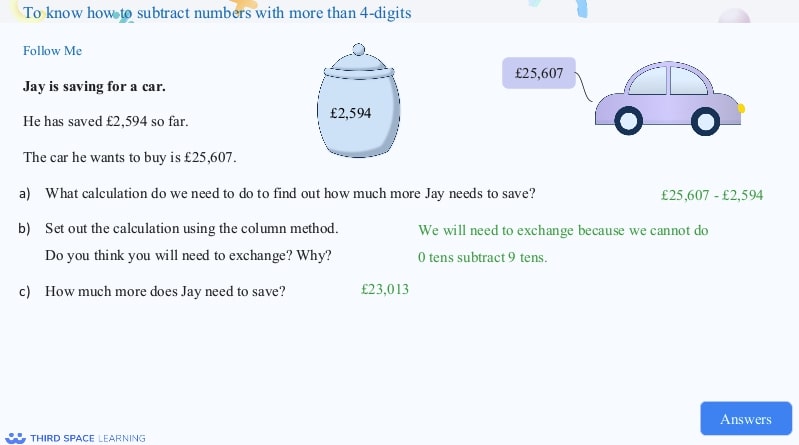
Year 5 pupils need to apply their knowledge of addition and subtraction to worded problems.
This problem addresses exchanging, which some pupils can find confusing,
especially when 0 is involved in the minuend.
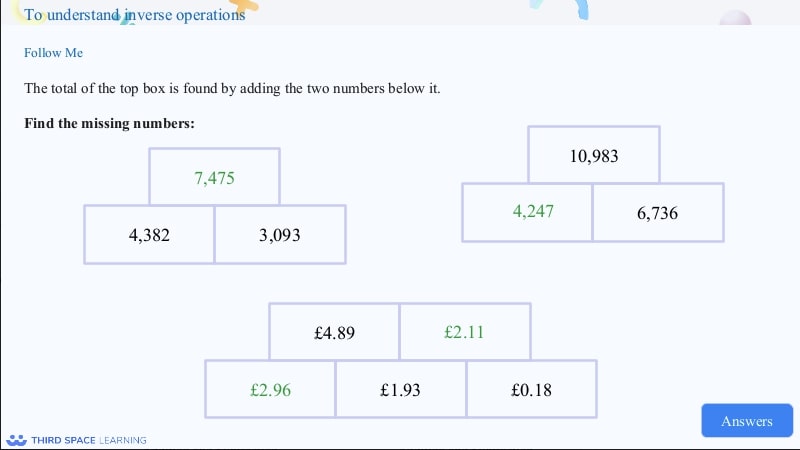
This example encourages pupils to explore the inverse relationship between
addition and subtraction while also applying their understanding to
their previous learning (expressing money using decimals).
Example year 5 addition and subtraction questions:
1. 52,378 + 87,659 =
Answer: 140,037
2. 86,143 – 48,967 =
Answer: 37,176
Multiplication and division Year 5
Multiplication and division is split into two blocks. It is covered initially in the autumn block 3, in Block A and continues with Block B in spring block 1.
Multiplication and Division A Year 5
The first multiplication and division block focuses on multiples, common multiples, factors, prime numbers, square numbers and cube numbers. Pupils also develop their understanding of multiplying by 10, 100 and 1000.
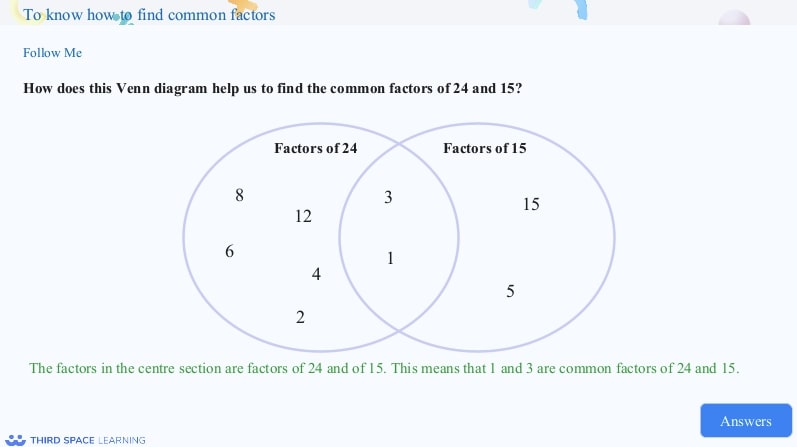
Year 5 pupils build upon their knowledge of factors by finding common factors of numbers.
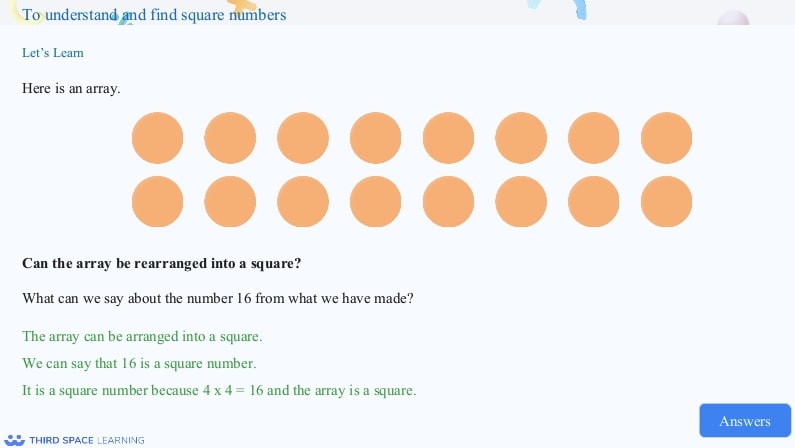
Pupils should be familiar with arrays when they are in Year 5.
They can use their understanding of arrays to explore square numbers.
Example year 5 multiplication and division A questions
1. Find the common factors for 12 and 36
Answer: 1, 2, 3, 4 and 6
2. Multiply 23 by 10, 100 and 100
Answer:
23 x 10 = 230
23 x 100 = 2300
23 x 1000 = 23,000
Fractions Year 5
Fractions are also split into two blocks, with Block A covered at the end of the autumn term and Block B in the spring term.
Fractions A Year 5
Fractions A is the first of the two fraction blocks taught in Year 5. Pupils continue to develop their understanding of equivalent fractions and learn how to convert between improper fractions and mixed numbers. In block A, students build on the skills developed in Year 4; progressing from adding and subtracting fractions to adding adding and subtracting mixed numbers.
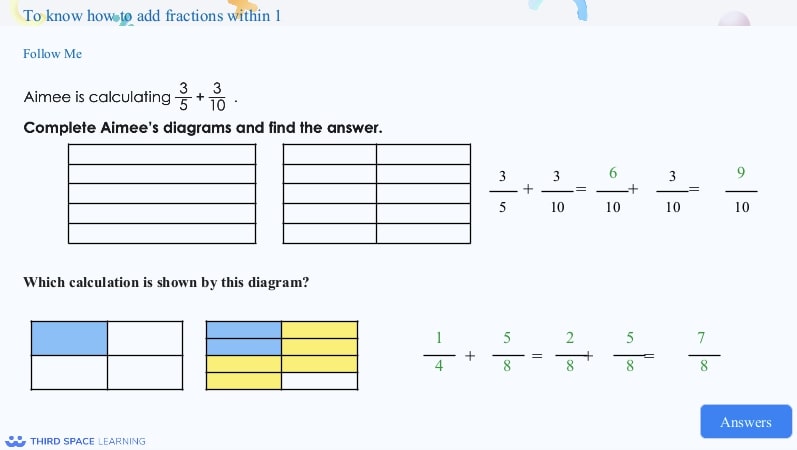
Pupils move on from adding and subtracting fractions with the same denominator
to adding and subtracting fractions with different denominators.
This extends to fractions greater than 1.
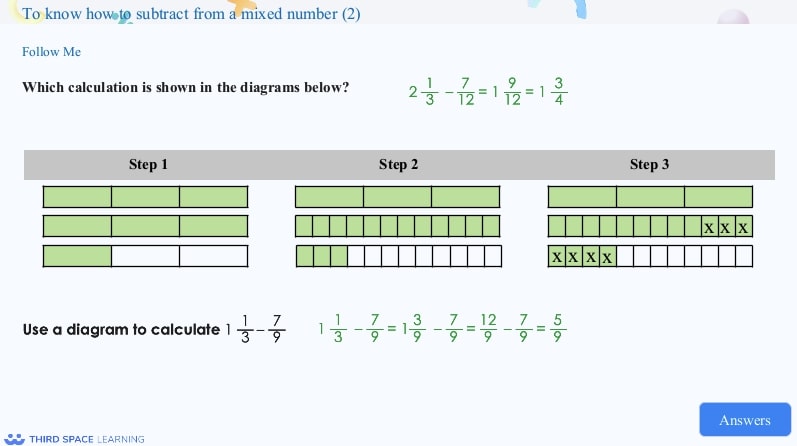
This example demonstrates how diagrams can be used to explain
how to subtract a fraction from a mixed number.
Example year 5 Fractions A questions
1. Give 3 fractions which are equivalent to 2332
Answer: Any fraction where the numerator and denominator have been multiplied by the same amount
E.g. 46,69,812,101564,96,128,1510
2. 514+628=541+682=
Answer: 11481184 or 1112=1121=
White Rose Maths Year 5 spring term
In the spring term, Year 5 focuses on multiplication & division, fractions, decimals & percentages, perimeter & area and statistics.
Multiplication and Division B Year 5
In the second multiplication and division block, students spend time developing their skills of formal written methods. For multiplication, they begin by multiplying numbers up to 4-digits by a 1-digit number and progress to multiplying by a 2-digit number. Pupils are introduced to the short division (bus stop) method, initially, focusing on dividing a 4 -digit number by 1-digit, progressing to division with remainders. These formal written methods are then applied to problem solving situations.
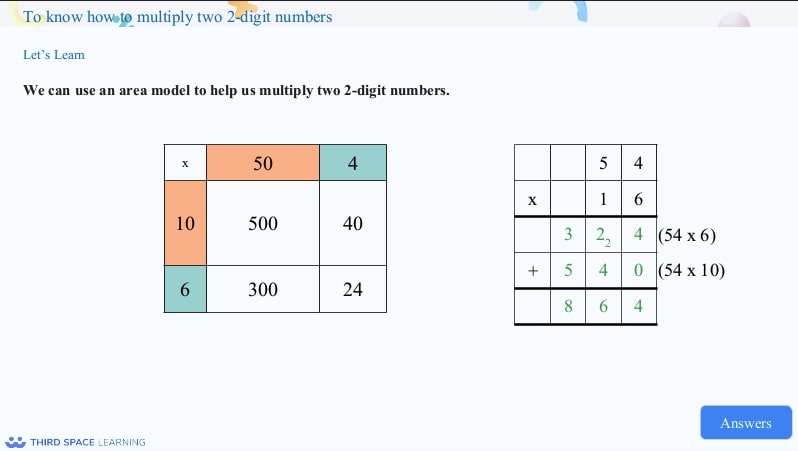
This example shows pupils moving from the area model to a
formal written method of multiplication.
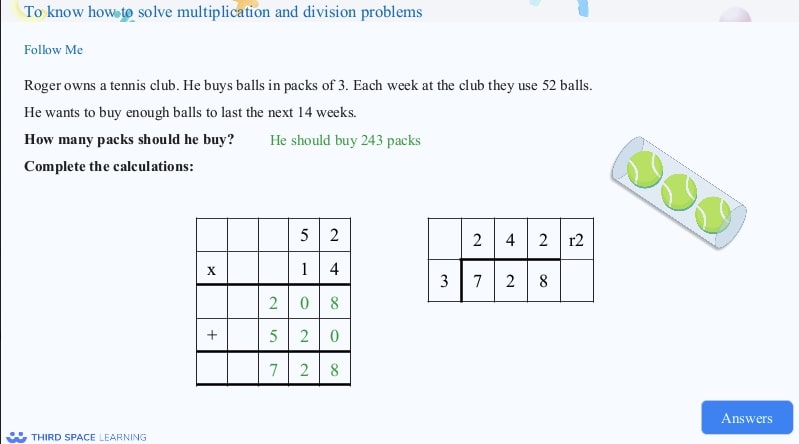
Pupils are given a chance to apply their understanding of multiplication
and division through problem solving.
Example year 5 Multiplication and division B questions
1. 6432 x 54 =
Answer: 347,328
2. 7564 ÷ 6
Answer: 1260 r. 4
Fractions B Year 5
In this second, shorter fractions block, pupils learn to multiply fractions; initially multiplying fractions by integers, progressing to multiplying mixed numbers by integers. Students also continue to build on their skills of calculating fractions of amounts.
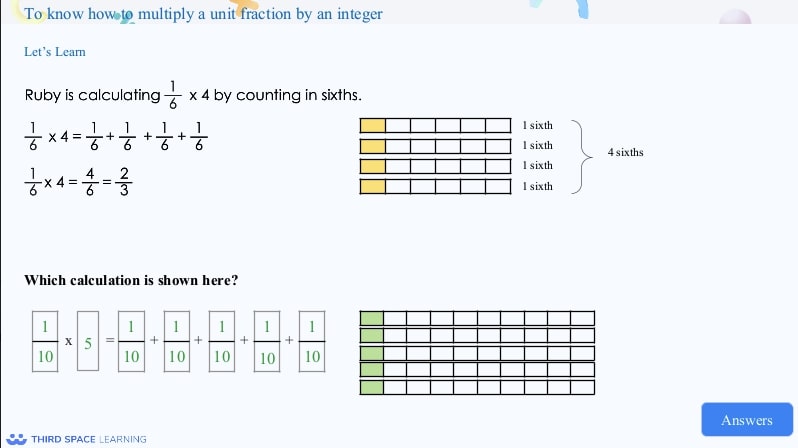
Pupils begin by exploring the link between multiplication and repeated addition using fractions.
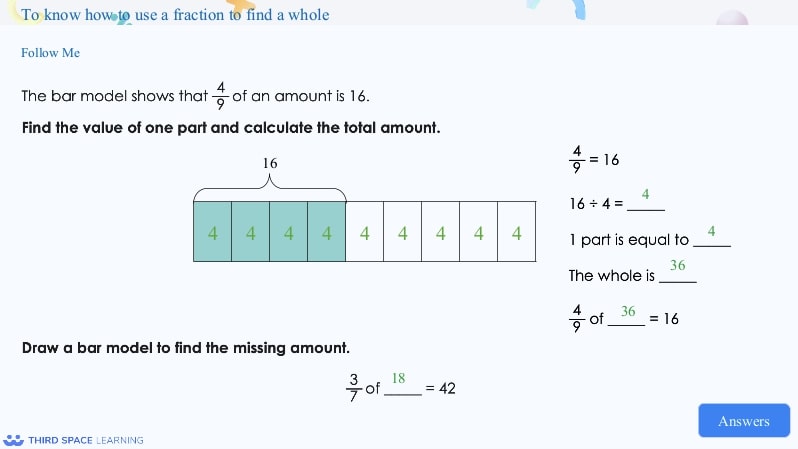
Pupils explore finding fractions of amounts, including finding the
whole from a given fraction of an amount.
Example year 5 fractions B questions
1. Calculate 3553 of 270
Answer: 162
Decimals and percentages Year 5
In Year 5, pupils are exposed to decimals in the spring term, but again in a topic of its own in the summer term. Pupils learn to make connections between fractions, decimals and percentages. Students begin by investigating the equivalence between fractions and decimals as tenths, hundredths and thousandths, followed by ordering and comparing decimals up to 3 decimal places and rounding decimals to the nearest whole number. Pupils are first introduced to percentages in Year 4. This is built upon Year 5, when they really develop their understanding of the link between percentages, decimals and fractions.
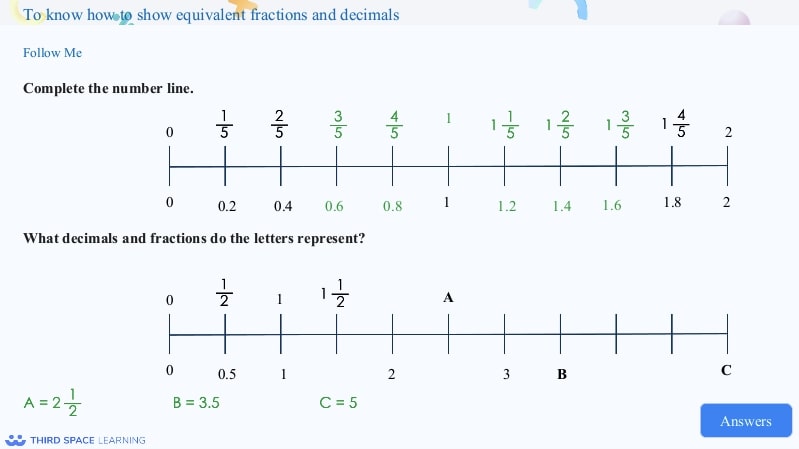
Pupils explore equivalent fractions and decimals, including those greater than one.
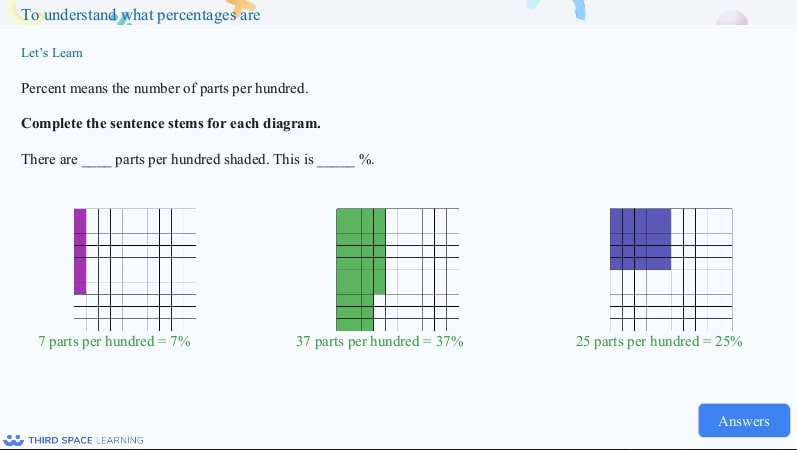
Pupils begin by exploring what the word ‘percent’ means and how
percentages are related to fractions and decimals.
Example year 5 decimals and percentages questions
1. Write 4220020042 as a decimal and a percentage
Answer: 0.21 & 21%
2. Order the following numbers from smallest to largest
53.23 53.2 53.03 53.3
Answer: 53.03, 53.2, 53.23, 53.3
Perimeter and area Year 5
Perimeter and area is a short topic in Year 5. Pupils build on the knowledge gained in Year 4, to measure and calculate the perimeter of composite rectilinear shapes and to calculate the area of rectangles and other irregular shapes.
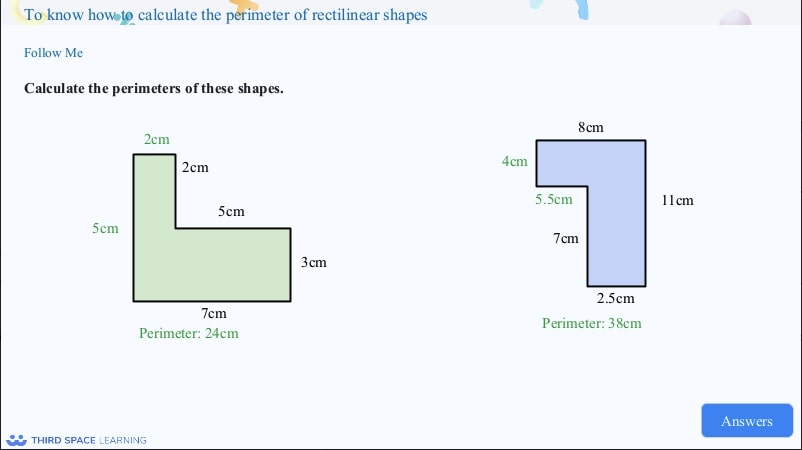
Pupils will have looked at finding the perimeter of rectilinear shapes in Year 4.
This is continued in Year 5, including where rectilinear shapes have
multiple missing sides, including side with decimals.
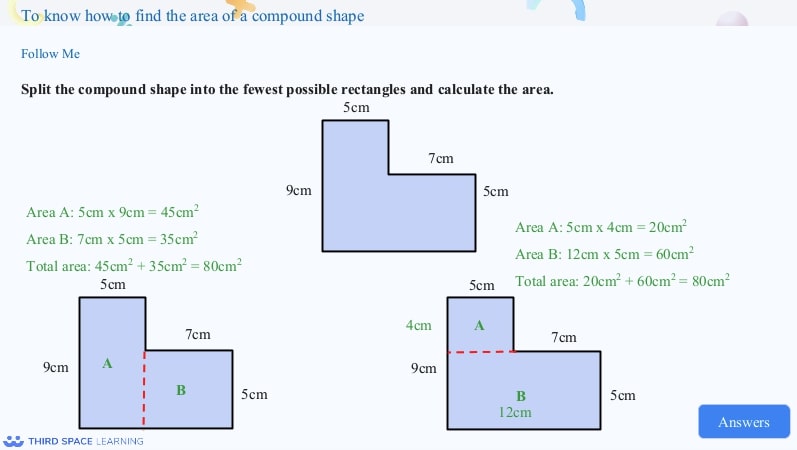
Pupils extend their understanding of area by finding the area of compound shapes.
Example year 5 perimeter and area questions
1. A regular hexagon has sides which are 7.5cm in length. What is the perimeter of the hexagon?
Answer: 45cm
2. A kitchen is 6.5m long and 3m wide. What is its area?
Answer: 19.5cm
Statistics Year 5
In Year 5, pupils build on the statistics work completed in Year 4; connecting their work on coordinates and scales to their interpretations of time graphs. At this stage pupils are also introduced to reading and interpreting timetables.
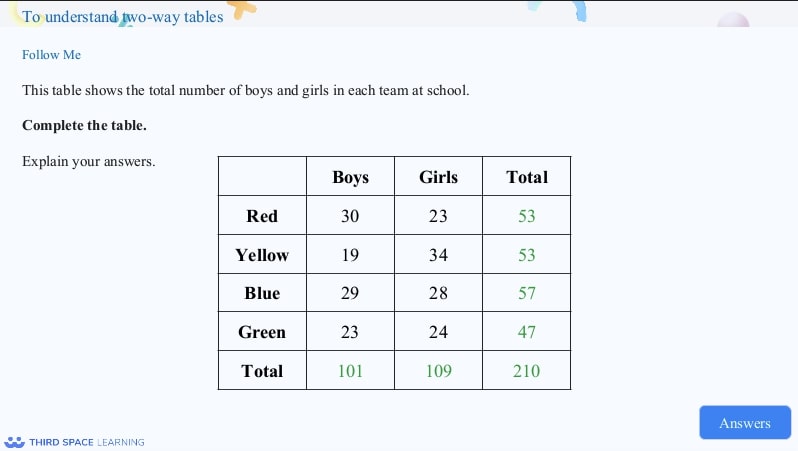
Pupils look at reading, interpreting and completing two-way tables in Year 5.
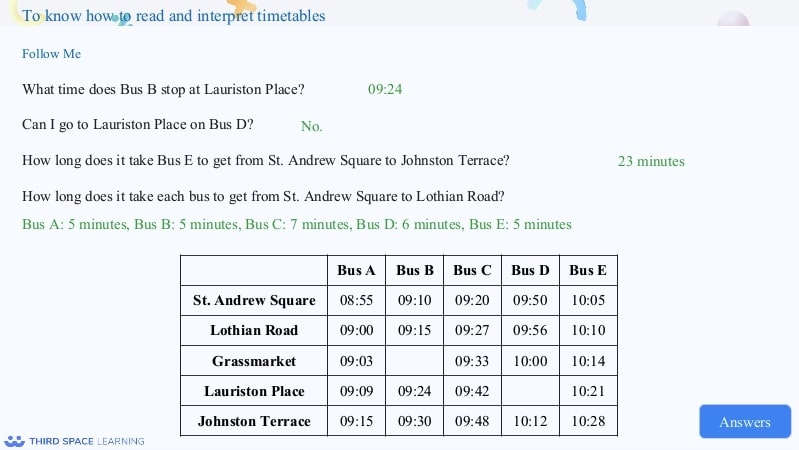
Understanding timetables is an important life skill that is explored in Year 5.
Pupils need to be able to read and interpret timetables,
while also using them to calculate durations.
Example year 5 statistics questions
1 .Monthly rainfall was measured for a year. Results are recorded in the table below. Use these results to create a line graph.
| Month | Rainfall (mm) |
| January | 43mm |
| February | 35mm |
| March | 64mm |
| April | 82mm |
| May | 104mm |
| June | 108mm |
| July | 101mm |
| August | 98mm |
| September | 86mm |
| October | 79mm |
| November | 65mm |
| December | 52mm |
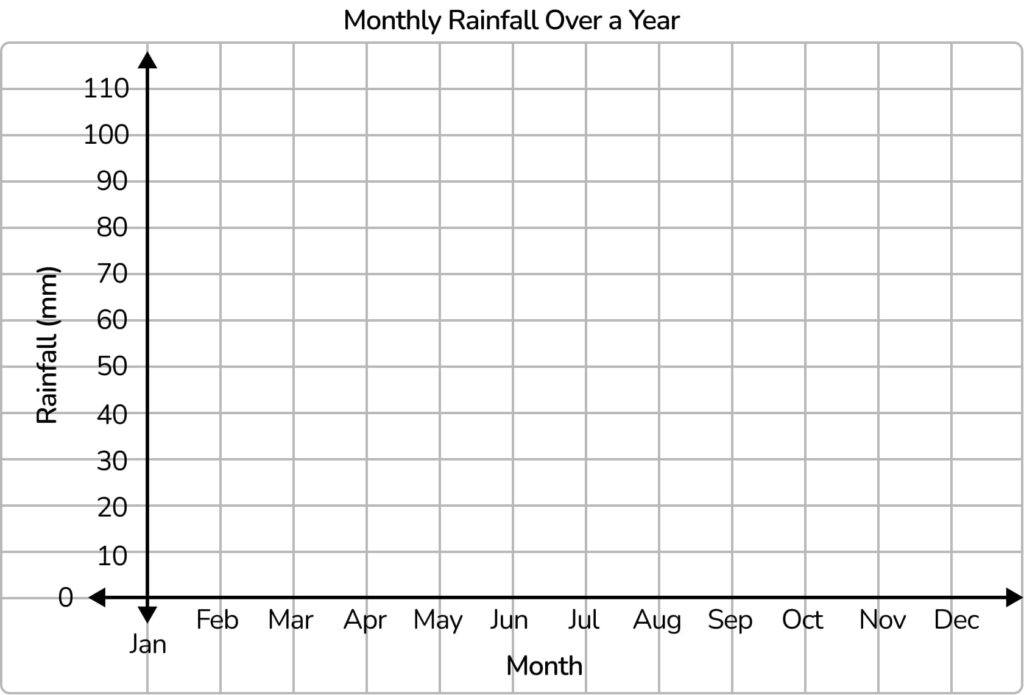
Answer:
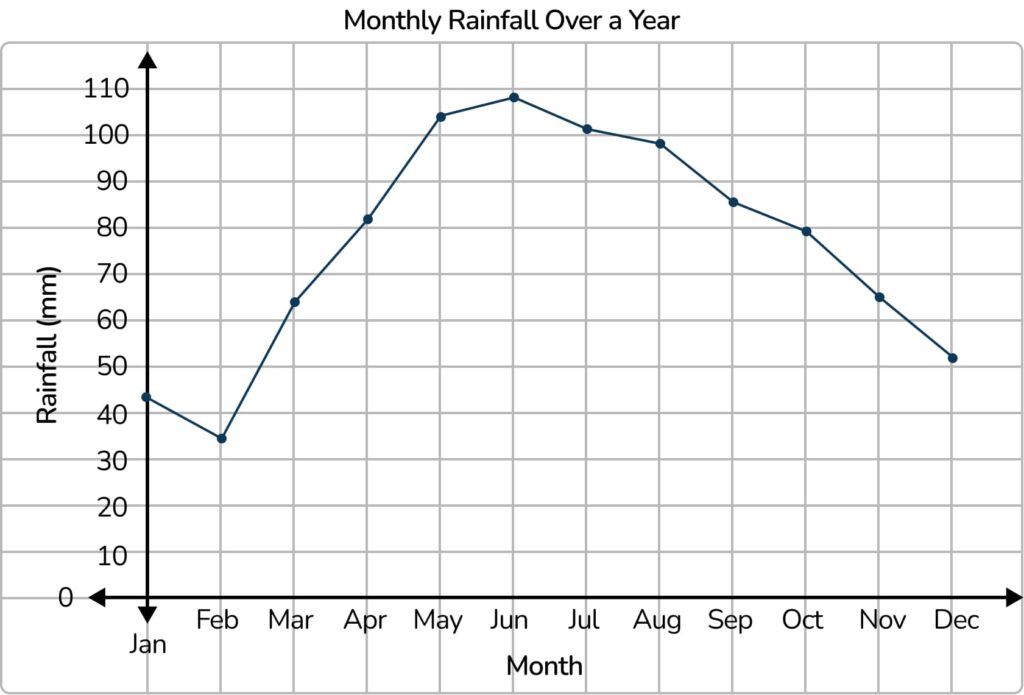
White Rose Maths Year 5 summer term
In the summer term, Year 5 focuses on shape, position & direction, decimals, negative numbers, converting units and volume
Shape Year 5
In summer block 1 of Year 5, pupils become more accurate in drawing lines with a ruler to the nearest millimetre and measuring with a protractor. Students learn to identify angles at a point and one whole turn, and angles at a point and on a straight line. Pupils use the properties of rectangles to deduce facts about missing lengths and angles and distinguish between regular and irregular polygons based on reasoning about equal sides and angles. Students also become more familiar with 3D shapes.
Example year 5 shape questions
1. Calculate the size of angle a
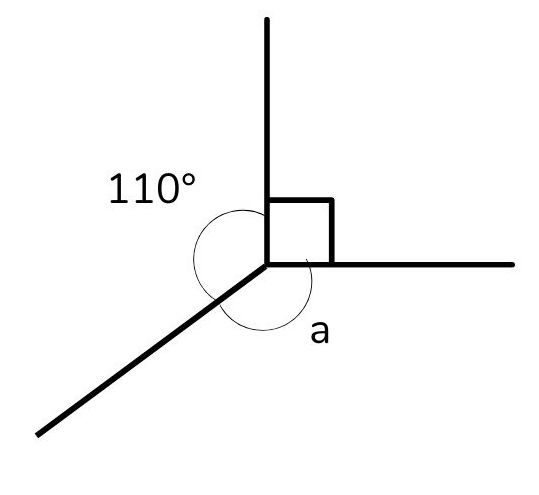
Answer: 160°
2. Explain why a square is a regular polygon.
Answer: A square has all sides the same length and all angles the same size.
Position and Direction Year 5
In Year 5, pupils recognise and use reflection and translation in a variety of diagrams. They build on their knowledge from Year 4; continuing to use a 2D grid and coordinates in the first quadrant and translating with coordinates. Students also continue to build on their understanding of symmetry; reflecting in horizontal and vertical lines.
Example year 5 position and direction questions
1.Plot the following coordinates on a grid:
(2,3) (4,3) and (4,5)
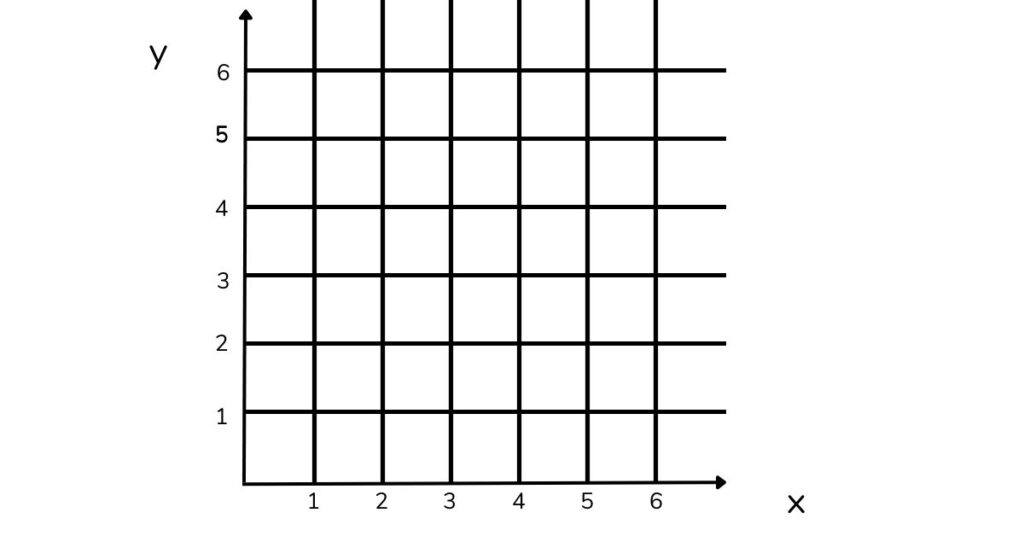
2. What coordinates would you need to plot to make a square?
Answer: 4th coordinate = (2,5)
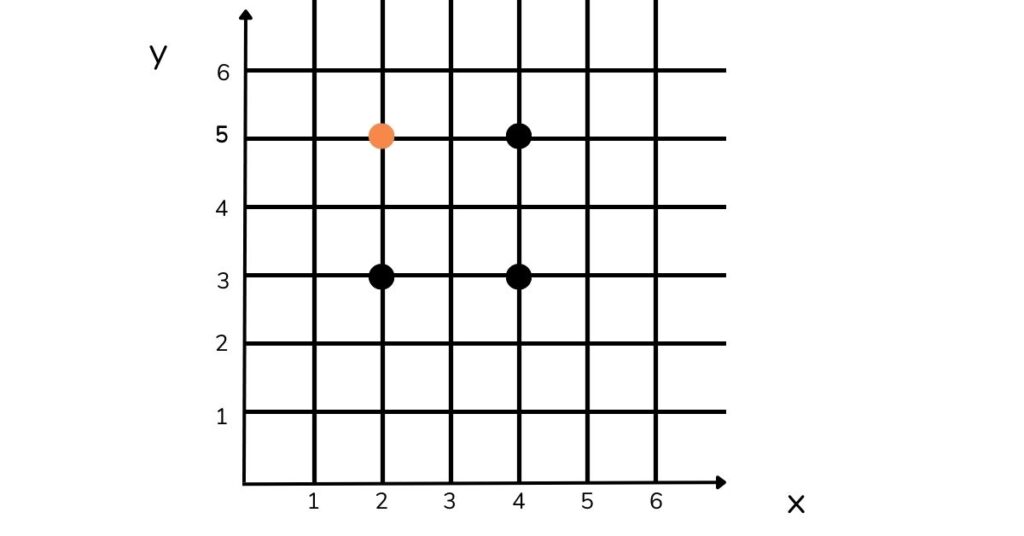
Decimals Year 5
The summer term is the second time pupils are exposed to decimals. In this topic, pupils add and subtract decimals; initially with the same number of decimal places, but then progressing to different numbers of decimal places. Students also multiply whole numbers and decimals by 10, 100 and 1000.
Example year 5 decimals questions
1. Multiply 0.34 by 10, 100 and 1000
Answer:
0.34 x 10 = 3.4
0.34 x 100 = 34
0.34 x 1000 = 340
2. 7.34 – 5.368 =
Answer: 1.972
Negative Numbers Year 5
This is a very short block, in which pupils begin to understand negative numbers. They begin by counting through zero in 1s, followed by counting through zeros in multiples. Students also compare and order negative numbers and find the difference.
Example year 5 negative number questions
1. 3 – 14 =
Answer: -11
2. What is the difference between -17 and 8
Answer: 25
Converting Units Year 5
In Year 5, pupils convert between a range of units; including kilograms and kilometres; millimetres and centimetres; centimetres and metres; grams and kilograms and litres and millilitres. In this block, students also convert units of time and calculate with timetables.
Example year 5 converting units questions
1. 5.34kg = ______g
Answer: 5340g
2. A film starts at 7:25pm and lasts for 1 hour and 35 minutes. What time does it finish? Give your answer in 24 hour clock.
Answer: 21:00
Volume Year 5
This is a very short final block in Year 5. Pupils learn about cubic centimetres and comparing volume. They also estimate volume and capacity.
Example year 5 volume questions
1. What is the volume of the shape below, if each cube is 1cm x 1cm x 1cm?

Answer: 18cm33
